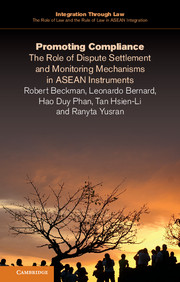Book contents
- Frontmatter
- Contents
- List of figures
- General editors’ preface
- List of abbreviations
- Introduction: overview and research rationale
- 1 The normative and theoretical underpinnings of ASEAN compliance behaviour
- 2 Dispute settlement mechanisms in ASEAN
- 3 Compliance monitoring mechanisms in ASEAN
- 4 Recommendations
- Executive summary
- Appendix 1 CIL’s observation on dispute settlement clauses in selected ASEAN agreements adopted prior to the ASEAN Charter
- Appendix 2 List of ASEAN instruments' provisions related to treaty compliance
- Bibliography
- Index
2 - Dispute settlement mechanisms in ASEAN
Published online by Cambridge University Press: 05 March 2016
- Frontmatter
- Contents
- List of figures
- General editors’ preface
- List of abbreviations
- Introduction: overview and research rationale
- 1 The normative and theoretical underpinnings of ASEAN compliance behaviour
- 2 Dispute settlement mechanisms in ASEAN
- 3 Compliance monitoring mechanisms in ASEAN
- 4 Recommendations
- Executive summary
- Appendix 1 CIL’s observation on dispute settlement clauses in selected ASEAN agreements adopted prior to the ASEAN Charter
- Appendix 2 List of ASEAN instruments' provisions related to treaty compliance
- Bibliography
- Index
Summary
Due to its turbulent beginnings, ASEAN's preoccupation with regional dispute management never truly diminished. Instead, dispute settlement modalities took on increasingly sophisticated roles in response to geopolitical and economic influences. This Chapter examines the evolution of ASEAN dispute settlement mechanisms pertaining to hard security issues and economic challenges, as well as the region's focus on reinforcing the rule of law and the strength of its institutions, and the extent to which such mechanisms are effective in fulfilling ASEAN's aspirations.
Phases in the development of ASEAN dispute settlement mechanisms
The early phase: promotion of regional peace and security
Generally, in this phase of regional peace maintenance and conflict avoidance, ASEAN lacked a clear and systematic practice on the inclusion of dispute settlement clauses in its instruments. Most ASEAN instruments adopted in the period from 1967 to 1991 did not include such provisions and there are no clear reasons as to why it is so. This was also the case with ASEAN agreements signed with external parties prior to 1992. This could be because state parties deemed these ASEAN agreements to be political confidence-building measures instead of legally binding treaties.
The TAC, signed in conjunction with the Bali Concord I on 24 February 1976 at the First ASEAN Summit, perfectly encapsulates ASEAN's attitude towards dispute settlement mechanisms in its early years. The TAC is the principal security treaty of the region and by signing it, state parties not only affirmed that the peaceful settlement of disputes was a ‘fundamental principle’, but also had recourse to a mechanism to resolve any situation that could destabilise regional peace and harmony. As non-regional states are permitted to be signatories, the TAC is the only regional mechanism that can be used for disputes arising between an ASEAN state and a non-ASEAN state. Accession to the TAC by non-ASEAN states has become an important indication of their commitment to engage in the region; it is also a requirement for joining the East Asia Summit. To date, many non-ASEAN countries have acceded to the treaty, including Australia, China, the European Union, India, Japan, Russia, the United States of America, South Korea and Timor-Leste.
The 2001 Rules of Procedure of the High Council of the TAC set out several steps that state parties should follow in the event of a dispute. First, state parties are to resolve their dispute through negotiation.
- Type
- Chapter
- Information
- Promoting ComplianceThe Role of Dispute Settlement and Monitoring Mechanisms in ASEAN Instruments, pp. 58 - 100Publisher: Cambridge University PressPrint publication year: 2016

